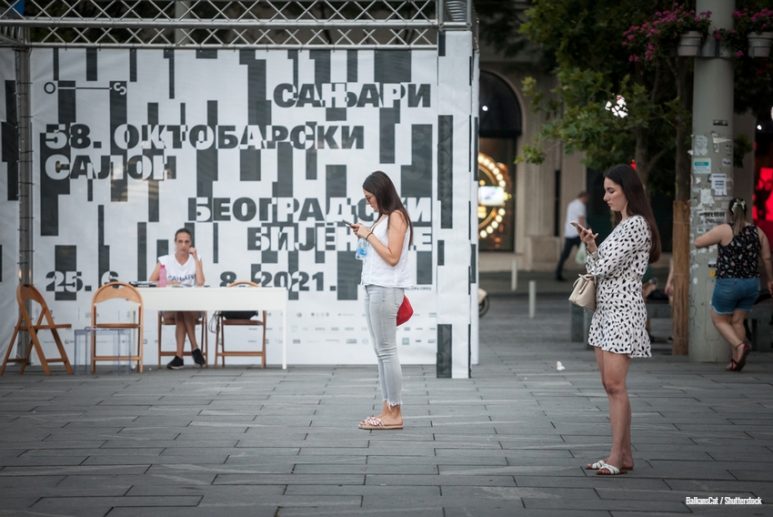By Ivana Jovanovic
Young people are portrayed as a homogeneous group in the Serbian mainstream media, and according to the Youth in the Media Mirror 2021 research, a stereotypical pattern of reporting involves a picture of a violent, drunk young man under the influence of drugs, as well as a promiscuous girl.
According to the research, the proportion of overall space in the media dedicated to young people with disabilities, young LGBTQ+ people or young people who are members of a national minority is only 5%.

The 2021 Youth in the Media Mirror research is conducted as a continuation of Youth in the Media Mirror studies from 2017, 2018, 2019 and 2020. The novelty of this year’s research is the analysis of the gender dynamics and perspective of Serbia’s YouTube scene.
Analysis of mainstream media in 2021 shows that there is twice as much content about young people compared to the previous year, primarily due to even more detailed reporting on crime and violence and due to the topic of youth vaccination. Negative context in the mainstream media is more common than positive.
According to research results, “when a certain crime occurs in which a young person is a victim or perpetrator, the tabloid media follow the case for days, racing to get as many details as possible, not stopping from spreading misinformation and violating the principles of journalistic attention and the presumption of innocence”.
For every report about activism in the mainstream media, there are 13 reports detailing criminal activity or violence. However, youth portals have shown far greater sensitivity to reporting on youth activism than the mainstream media. Also, in a society where it is still a taboo to talk about mental health, youth portals reported on this topic, which contributes to raising awareness and breaking prejudices about mental health.
According to the Production and Distribution of Youth Oriented Content in Serbia: Professional and Ethical Standards, youth portals report on topics of public interest, publish educational content, advocate for human rights, do not use clickbait or hatebait, and rarely violate journalistic ethics. However, according to the recommendations in this study, in order to balance a professional and attractive approach, youth media should try to communicate frequently with their audiences in order to provide feedback.
When we look at the Youth in the Media Mirror 2021 results, as well as the results of the Production and Distribution of Youth Oriented Content in Serbia: Professional and Ethical Standards research, it is not surprising that a large number of young people choose to not be informed by the mainstream media, but instead chose to access news and information through social networks (TikTok, YouTube, Instagram) and youth portals.
Mainstream media outlets need to find more effective ways to address their audiences, for example by opening spaces for young people in their newsrooms. According to the Production and Distribution of Youth Oriented Content in Serbia: Professional and Ethical Standards research – “a diversity of genres in youth programs is provided only by public broadcasters (RTS and RTV)” and “TV Happy and TV Pink did not publish a minute of content for young people”.
On the other side, social networks such as TikTok provided open platforms for minority groups, such as the LGBTQ+ community, to talk about their position and emphasize the importance of human rights. TikTok is also used to popularize science, media literacy and the fight against disinformation. However, according to the recommendations in the Production and Distribution of Youth Oriented Content in Serbia: Professional and Ethical Standards research, TikTok should establish “a rapid response system to content that violates community standards, especially if the clips contain violence, self-harm, calls for dangerous challenges, or hate speech”, and cooperate with state institutions in cases of cyberbullying, revenge pornography, etc.
The analysis of the gender perspective of Serbia’s YouTube scene shows that the list of 20 channels with the largest number of followers in 2021 included 13 men, 3 women (Lea Stanković, Kika and Marija Žeželj), and 4 group channels. The content created by women is not only underrepresented, but also exposed to far stronger and more numerous negative comments from audiences.
In the Youth in the Media Mirror 2021 report, it is said that a certain range of public expectations are applied to women’s channels, and if women do not follow them, it is difficult for them to achieve greater levels of visibility. YouTube, as it states in the research, “perpetuates power relations between genders according to the same model that is being developed in mainstream media”.
According to the report, most of the analyzed clips are value-neutral (harmless), and those that are not value-neutral are affirmative – aimed at strengthening self-confidence, understanding, tolerance and learning. If we compare this year’s findings with those from the previous two years, we can conclude that female YouTube creators make up a less visible, but more ethical, part of the Serbia’s YouTube scene.
Downloads
Youth in Media Mirror 2021
Production and Distribution of Youth Oriented Content in Serbia: Professional and Ethical Standards
Photo Credits: BalkansCat / Shutterstock

